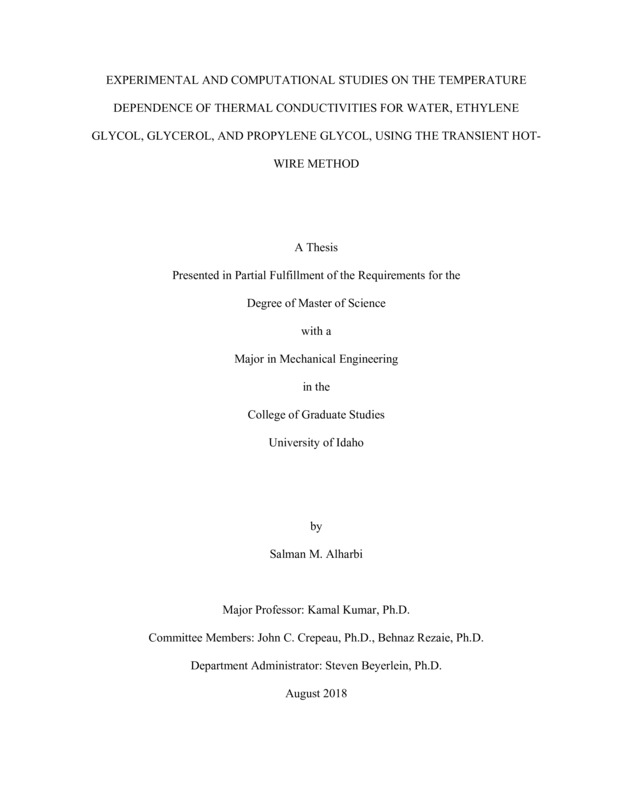Experimental and Computational Studies on the Temperature Dependence of Thermal Conductivities for Water, Ethylene Glycol, Glycerol, and Propylene Glycol, Using the Transient Hot-Wire Method
Alharbi, Salman. (2018-08). Experimental and Computational Studies on the Temperature Dependence of Thermal Conductivities for Water, Ethylene Glycol, Glycerol, and Propylene Glycol, Using the Transient Hot-Wire Method. Theses and Dissertations Collection, University of Idaho Library Digital Collections. https://www.lib.uidaho.edu/digital/etd/items/alharbi_idaho_0089n_11436.html
- Title:
- Experimental and Computational Studies on the Temperature Dependence of Thermal Conductivities for Water, Ethylene Glycol, Glycerol, and Propylene Glycol, Using the Transient Hot-Wire Method
- Author:
- Alharbi, Salman
- Date:
- 2018-08
- Keywords:
- Ethylene Glycol Glycerol Propylene Glycol Thermal conductivity Transient Hot-Wire Water
- Program:
- Mechanical Engineering
- Subject Category:
- Mechanical engineering
- Abstract:
-
The goal of this work is to provide experimental measurements of thermal conductivity of water, ethylene glycol, glycerol, and propylene glycol as a function of temperature. The transient hot wire method was used to measure the thermal conductivity over temperatures ranging from 235–340 K. This work also involved in-house apparatus fabrication along with integration of data acquisition and processing software. The experiments are carried out for a fixed current of 250 mA and the resulting temperature rise of a 95.33 mm long, 25-micron radius platinum wire is used to infer the thermal conductivity using the known solution to the heat conduction equation for a continuous line source in an infinite medium. It is important to account for the variable temperature coefficient of resistance of the platinum wire as a function of temperature when seeking to obtain the correct temperature dependence of the thermal conductivity. A data reduction procedure that improves the accuracy of the reported values by identifying the onset of convection in the fluid is proposed. We use the peak value of the slope (S) obtained using a third order polynomial fit to the apparent linear region to estimate the thermal conductivity. The high-resolution data acquired at closely spaced temperature intervals is used to derive a correlation between thermal conductivity values and the fluid temperature. Additionally, numerical results for temperature and velocity field near the heated wire are also presented to help understand the non-idealities present in the experiments. The experimental temperature rise obtained from the transient hot-wire experiments is compared to computed values for water at room temperature, and a good agreement is found. There is a fair agreement between the current data sets and the very limited data for the four liquids reported in the literature. This work provides robust and comprehensive experimental data for thermal conductivities of the four common heat transfer fluids over the typical range of temperatures they are frequently used.
- Description:
- masters, M.Engr., Mechanical Engineering -- University of Idaho - College of Graduate Studies, 2018-08
- Major Professor:
- Kumar, Kamal
- Committee:
- Crepeau, John; Rezaie, Behnaz
- Defense Date:
- 2018-08
- Identifier:
- Alharbi_idaho_0089N_11436
- Type:
- Text
- Format Original:
- Format:
- application/pdf
- Rights:
- In Copyright - Educational Use Permitted. For more information, please contact University of Idaho Library Special Collections and Archives Department at libspec@uidaho.edu.
- Standardized Rights:
- http://rightsstatements.org/vocab/InC-EDU/1.0/

